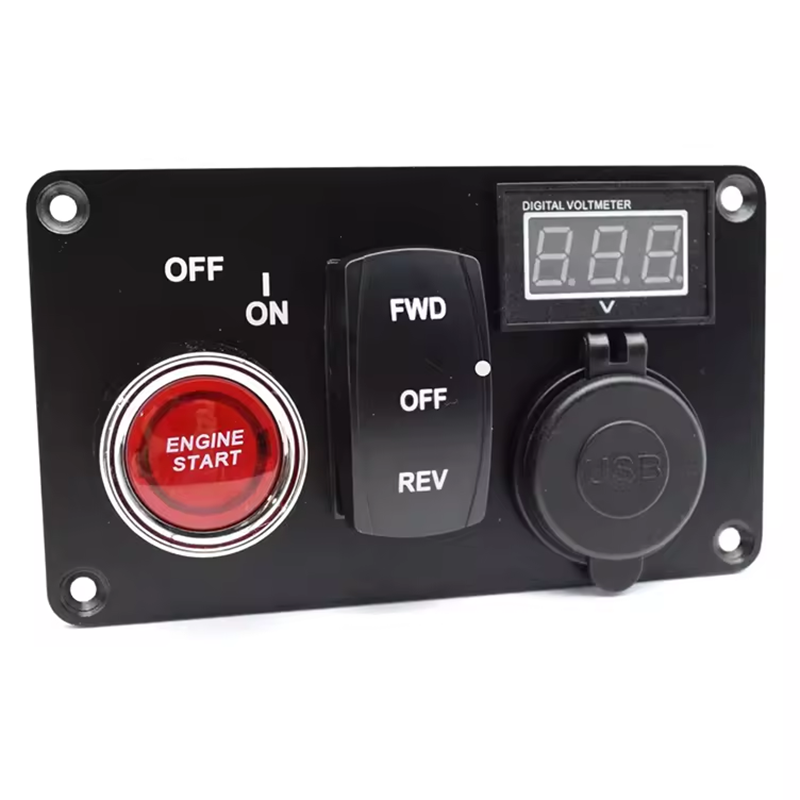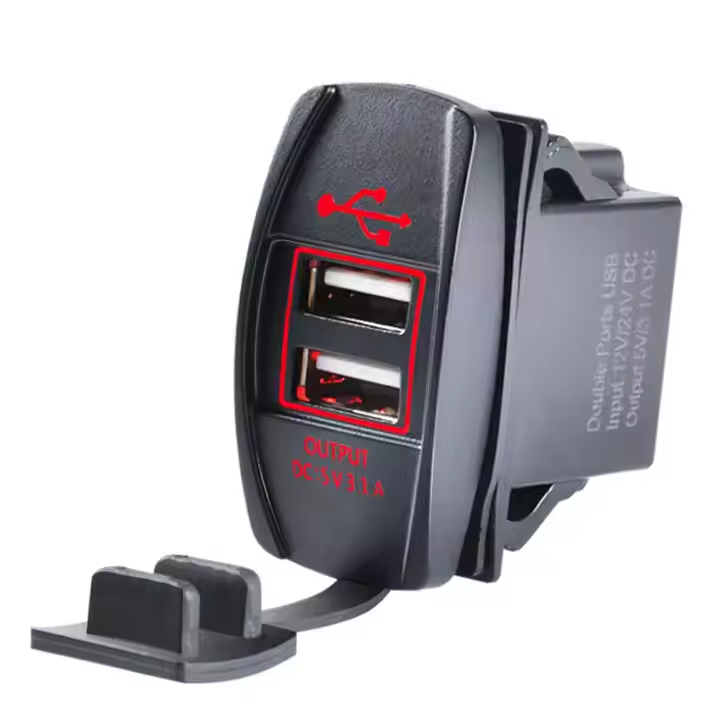Apr 15,2025
0
Understanding the voltage requirements for USB charger sockets, which typically operate at 5V, is crucial for ensuring compatibility with your vehicle's system. Most vehicles are equipped with either a 12V or a 24V electrical system, depending on the size and type of the vehicle. Smaller vehicles like cars usually have a 12V system, whereas larger vehicles like trucks often have a 24V system. When selecting a USB charger socket, it's important to match the charger's voltage requirements with your vehicle's voltage system. Research indicates that using the wrong voltage can lead to device damage or inefficient charging, which could potentially harm your electronic devices over time.
Fast charging technology, such as Quick Charge 3.0 (QC3.0), has become increasingly important in our fast-paced lives. This technology allows devices to charge up to four times faster than standard chargers, making it a favorable feature for those constantly on the go. QC3.0 support in a USB vehicle charger is particularly beneficial during long road trips or when you have multiple devices that need charging simultaneously. In such scenarios, charging speed can significantly enhance your travel experience by ensuring that all devices are powered up efficiently and quickly.
The materials used in manufacturing USB chargers can greatly impact their durability and longevity. Common materials like plastic and aluminum provide varying degrees of toughness and resilience to external conditions. Aluminum, for example, generally offers superior durability compared to plastic, making it a preferable choice for automotive accessories. Additionally, waterproof ratings, such as IP67, ensure that the USB charger can withstand exposure to elements like rain or dust. According to experts, products with high durability and robust waterproof ratings often enjoy a longer lifespan and deliver better overall performance in demanding environments.
When it comes to choosing USB charger sockets for your vehicle, space-saving designs and multi-function panels each offer unique advantages. Compact designs are ideal for conserving dashboard space and maintaining a tidy interior, while multi-function panels come equipped with multiple USB ports and extra features, enhancing versatility. User reviews widely favor solutions that maximize functionality without occupying too much space. Therefore, selecting a design that aligns with your space and functional requirements could improve both practicality and aesthetic appeal in your vehicle.
Safety features like overload protection and short circuit protection are paramount when selecting USB charger sockets for your vehicle. These features help prevent damage to your charging devices and mitigate potential hazards within your vehicle’s electrical system. According to safety organization statistics, products equipped with these protective mechanisms tend to have lower failure rates, making them a safer option for users. Choosing USB chargers with built-in protective features not only safeguards your devices but also offers peace of mind during daily usage.
Each of these considerations plays a vital role in selecting the appropriate USB charger socket, ensuring functionality, compatibility, and safety in your vehicle's charging setup.
DC 12V Rocker Switch Panel with Digital Voltmeter is designed to enhance the functionality of any vehicle's electrical system. This panel is equipped with a user-friendly digital voltmeter, which plays a crucial role in effectively monitoring your vehicle's electrical systems, ensuring they operate within optimal parameters. Customers frequently note the straightforward installation process and ease of use, making this product a favored choice among vehicle enthusiasts. Such features ensure reliable power management and extend the lifespan of your electrical components.

For those seeking a seamless charging solution, the Rocker Switch Style Dual USB Fast Charger offers an innovative design that blends effortlessly with any vehicle interior. This charger not only looks modern but provides dual USB ports capable of fast charging, ensuring your devices get powered up efficiently, which is particularly beneficial during long journeys. Experts often recommend this fast charger due to its growing popularity among travelers who need reliable and speedy charging solutions on-the-go.

The Waterproof 4-Gang Toggle Panel with Dual USB Ports is perfect for those who need reliable performance under various outdoor conditions. Its waterproof design ensures it can withstand harsh environments, making it ideal for marine or adventure vehicles. This versatile 4-gang panel accommodates multiple devices simultaneously, offering robust construction and consistent reliability—key factors that reviews often highlight as its standout qualities. Its durable materials and engineering ensure it remains functional even in challenging settings.

Ensuring a perfect fit between USB charger sockets and dashboard space is crucial for both appearance and functionality. Accurate measurements can prevent installation challenges such as misalignment or loose fittings. To achieve precise measurements, one can use tools like calipers or measuring tapes. These facilitate accurate gauging of the dashboard area where the socket will be installed. Proper fitting not only looks better but also extends the life of the product by reducing stress on its components. Research suggests that a poor fit can lead to complications, including device damage due to increased vibration—a significant risk factor in vehicles.
Understanding the wiring requirements for different voltage systems is vital for the proper functioning of USB charger sockets in vehicles. Differentiating between 12V and 24V systems can help in streamlining the installation process. Typically, 12V systems are found in most cars, while 24V systems are common in larger vehicles like trucks. The complexity of the installation can vary accordingly. Experts recommend adhering to established wiring standards to avoid potential electrical issues, such as short circuits or power surges. Following these guidelines ensures not only the safety of the vehicle's electrical system but also enhances the reliable performance of the chargers.
Integrating USB chargers into existing switch panels can significantly boost a vehicle's functionality. To guide you through this process, consider a step-by-step approach where precision and caution are key. Firstly, assess the compatibility of your existing panel with the new USB chargers. You might need additional adapters or modifications to ensure a seamless integration. Considerations such as positioning and power distribution are vital to avoid conflicts with other systems. According to user surveys, a well-done integration not only enhances the vehicle's utility by allowing simultaneous device charging but also improves the overall driving experience by maintaining a clutter-free dashboard space.
To avoid electrical system overloads in vehicles equipped with USB chargers, it's crucial to implement several best practices. First, always ensure that the combined power draw from your devices does not exceed the vehicle's power capacity. Look for signs like flickering lights or blown fuses, which indicate a potential overload. Addressing these proactively can prevent more significant issues. According to automotive safety reports, electrical overloads rank among the top causes of failures. Hence, maintaining vigilance and regular checks are essential to sustain system robustness and extend the longevity of electronic components in your vehicle.
Maintaining clean USB charger contacts is vital for optimal charger performance and longevity. To do this effectively, gently wipe the contacts with a dry microfiber cloth to remove dust and debris. Avoid using water or corrosive substances, as they can lead to oxidation and reduce charging efficiency. Corrosion can significantly hinder the speed and even functionality of a charger. Mechanics suggest routine check-ups and cleaning every few months, emphasizing this simple maintenance can extend the lifespan of vehicle charging systems significantly by preventing wear and tear that typically result from moisture and neglect.
Recognizing when to upgrade older vehicle charging systems can enhance functionality and reliability. If you notice prolonged charging times, frequent disconnections, or if your system is incompatible with newer devices, it's time to consider an upgrade. Modern charging technology, such as USB-C, offers faster charging speeds and broader device compatibility over outdated systems. Surveys show vehicle owners report significant improvements in their charging experience and overall convenience after transitioning to updated systems. Such upgrades not only elevate user satisfaction but also provide future-proof solutions in the fast-evolving tech environment of today.